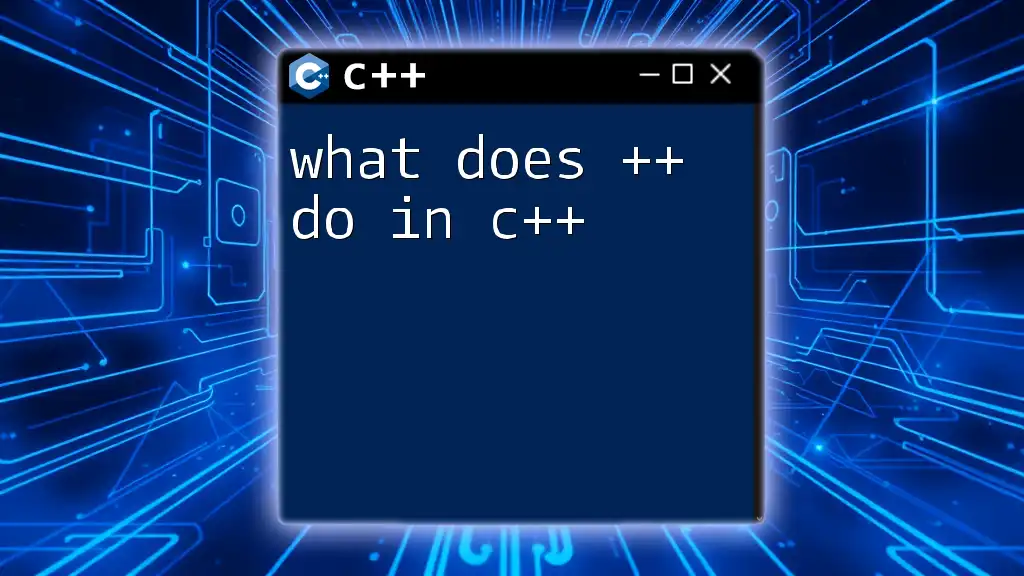The `push_back` function in C++ is used to add an element to the end of a vector, dynamically increasing its size.
Here’s a quick example:
#include <iostream>
#include <vector>
int main() {
std::vector<int> numbers;
numbers.push_back(10); // adds 10 to the end of the vector
numbers.push_back(20); // adds 20 to the end of the vector
for (int num : numbers) {
std::cout << num << " "; // outputs: 10 20
}
return 0;
}
Understanding Vectors in C++
What is a Vector?
In C++, a vector is a dynamic array that can grow and shrink automatically as elements are added or removed. Unlike traditional arrays, which require a fixed size, vectors offer flexibility and ease of use. They are part of the Standard Template Library (STL) and are essential for handling collections of data.
Key Characteristics of Vectors
Vectors come with several important characteristics that make them a preferred choice in many scenarios:
-
Automatic Memory Management: Vectors handle memory allocation and deallocation automatically. When elements are added, the vector dynamically allocates additional memory as needed, so the programmer does not need to worry about manual memory management.
-
Dynamic Resizing: Vectors can grow as required, meaning that the size of a vector is not fixed. When you add more elements than the current capacity, the vector will resize itself and allocate more memory to accommodate new elements.

The `push_back` Function
Overview of `push_back`
The `push_back` function is a member function of the vector class that allows you to add a new element to the end of a vector. This function is crucial for building up the contents of a vector dynamically.
Syntax of `push_back`
The basic syntax for `push_back` is as follows:
vector.push_back(value);
Here, `value` is the element you want to append to the vector. The type of this value must match the type specified when the vector was declared.

How `push_back` Works
Memory Allocation and Management
When an element is added to a vector using `push_back`, the following steps usually occur:
- Check Current Capacity: The vector first checks if the current capacity is sufficient to store the new element.
- Resize If Necessary: If there is not enough capacity, the vector will allocate new memory, generally doubling its size, copy the existing elements to the new memory location, and then free the old memory.
- Add the New Element: Finally, the new element is placed in the next available spot in the vector.
This process allows vectors to maintain performance while dynamically resizing, although frequent resizing can lead to performance overhead.
Performance Considerations
- The average time complexity for `push_back` is O(1), meaning it runs in constant time most of the time. However, in cases where resizing is needed, the operation could take longer, specifically O(n), where n is the number of elements in the vector.
- Understanding this performance characteristic is essential, especially when dealing with large datasets.

Example Usage of `push_back`
Basic Example
Here’s a straightforward example demonstrating how to use `push_back`:
#include <iostream>
#include <vector>
int main() {
std::vector<int> numbers;
numbers.push_back(1);
numbers.push_back(2);
numbers.push_back(3);
for (int num : numbers) {
std::cout << num << " ";
}
return 0;
}
In this code snippet, we declare a vector called `numbers` and use `push_back` to add integers to it. Finally, we iterate through the vector and print the numbers. The output will be: `1 2 3`.
Using `push_back` with Different Data Types
The `push_back` function can also be used with various data types. Here’s an example with strings:
#include <iostream>
#include <vector>
#include <string>
int main() {
std::vector<std::string> names;
names.push_back("Alice");
names.push_back("Bob");
for (const auto& name : names) {
std::cout << name << " ";
}
return 0;
}
Here, we create a vector of strings called `names` and use `push_back` to add names to it. The output will be: `Alice Bob`.

Common Use-Cases for `push_back`
Building Dynamic Arrays
Vectors and `push_back` make it easy to build dynamic arrays where the number of elements is not predetermined. This is particularly useful in applications where the input size can vary.
Collecting User Input
Using `push_back` for collecting user input is a common scenario. A program can repeatedly ask for input and store responses in a vector until a specific condition is met (like entering "exit").
Constructing Data Lists and Tables
In data handling, `push_back` is useful for collecting and managing list items. For example, if you are building a list of products, adding each product with `push_back` allows for seamless management of the collection.

Alternatives to `push_back`
Using `insert` Method
Another way to add elements to a vector is using the `insert` method, which allows you to place an element at a specific position rather than just at the end. This is useful if the order of elements is important.
Direct Assignment
You can also assign values directly to specific indexes of the vector, but this approach requires prior knowledge of the index to which you want to assign the value.

Best Practices for Using `push_back`
Preallocating Memory
To avoid frequent resizing and improve performance, you can preallocate memory using the `reserve` function:
std::vector<int> numbers;
numbers.reserve(100); // Allocate memory for 100 elements
This way, the vector can accommodate up to 100 elements without needing to resize.
Thread Safety Considerations
When using vectors in multi-threaded applications, be cautious. Modifying vectors is not thread-safe, and concurrent access can lead to undefined behavior. Consider using mutexes or other synchronization mechanisms when sharing vectors across threads.

Common Pitfalls and Troubleshooting
Unintentional Resizing
One common issue is when a vector is modified too frequently, causing performance issues due to repeated resizing. Being aware of the current capacity and preallocating memory can help mitigate this.
Accessing Out of Bounds
When using `push_back`, always ensure you do not try to access elements out of bounds. Accessing invalid indices can lead to runtime errors or crashes. Utilize the `at` method for bounds checking, which throws an exception if you try to access an invalid index:
try {
int value = numbers.at(10); // May throw an exception if the index is out of range
} catch (const std::out_of_range& e) {
std::cerr << "Index out of range: " << e.what() << '\n';
}

Conclusion
In summary, understanding what `push_back` does in C++ is vital for anyone looking to effectively manage collections of data using vectors. Its ease of use and dynamic sizing capabilities make it a powerful tool for developers. By incorporating best practices, such as preallocating memory and ensuring thread safety, you can maximize the performance and safety of your vector operations.

Additional Resources
To deepen your understanding, consider exploring the official C++ documentation on vectors and the STL. Additionally, online courses and textbooks can provide further insights into effective C++ programming and data structure management.

















